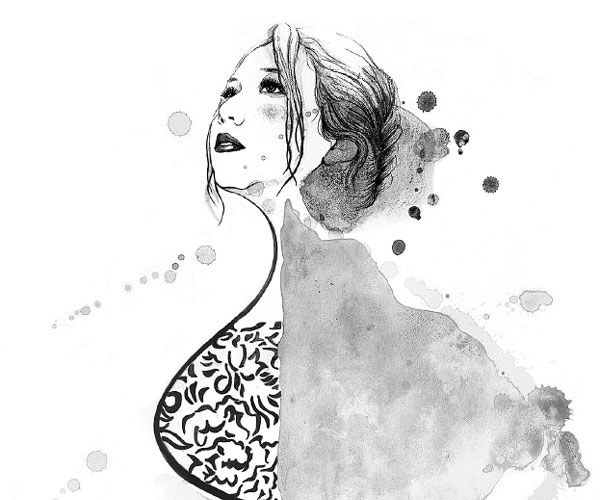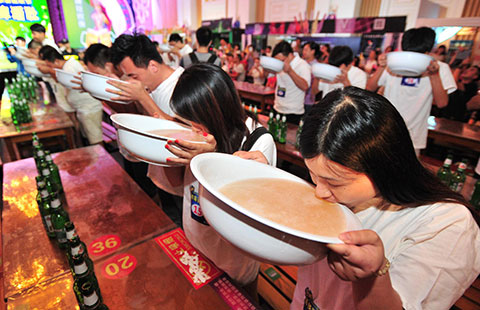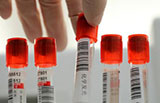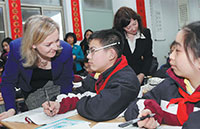The shape of things to come
By Yang Wanli (China Daily) Updated: 2015-03-26 07:33Shifting shapes

Decades ago, Wu's figure would have been unusual for a Chinese woman, but the situation has changed in recent years. In a recent interview with Vista Magazine, Yu Xiaodan, who has worked as a designer for such companies as Maidenform, Elle and Vera Wang Princess, said breasts are getting bigger worldwide.
Breast size, which is typically quoted in bra size, is determined by subtracting the band measurement from the cup measurement. Each inch represents a cup size, which is expressed in letters, The range begins at A (or AA in some countries), so a difference of 1 inch represents an A cup, while 3 inches represents a C cup. Differences greater than 4 inches are typically expressed in factors of D.
Yu said that when she began working as a designer 10 years ago, the average bra size in the UK was 34B, but it has now jumped to 36D. In the 1930s, US bra-sizing charts ranged from A to D, but now cover AA to F and even G. Larger sizes, such as J and K, can be found in some shopping malls, she added.
According to the website LiveScience, by 2013 the average breast size in the US had risen to 36C from 34B in 1995, and a survey conducted by the lingerie retailer Intimacy indicated that the average bra size in the US has jumped to 34E from 34B in the past 20 years.
China hasn't been immune to the global changes. The latest statistics from the China Physical Fitness Surveillance Center used a data comparison of the years 2000 and 2010, which showed that Chinese women had grown taller and their breasts had become fuller, despite no obvious weight increase during the decade.
Among women age 20 to 24, average breast size rose from 81.5 centimeters in 2000 to 82 in 2010, and height increased from 158.6 cm to 159. For the 25 to 29 age group, breast size rose to 83.4 cm in 2010 from 82.5 in 2000, and height increased to 158.7 cm from 158.2.
"The sizing charts for dressmakers in China have changed in tandem with developments across the world. The screening samples we've collected indicate that the proportion of B and C cups has risen," said Zheng Rong, a leading researcher at the Aimer Human Engineering Research Center at the Beijing Institute of Fashion Technology.
The center, launched in 2009 by the Chinese lingerie manufacturer Aimer, holds more than 8,000 samples of Chinese body types collected from people age 7 to 70. More than 70 percent of the examples are in the 18 to 50 age group, and women account for 80 percent of all samples.
Zheng said that in the 1990s, the most common bra sizes in China were 34A and 34B. "Now it's 34B and 34C. But only a few lingerie companies in China have invested in production and design facilities for larger sizes, such as 34D, because there are still so few customers, compared with Western countries," she said.
DNA and diet
Breast size is primarily determined by genetics, but diet and other factors, such as rising standards of living, also play decisive roles.
"Breasts are mostly made up of fatty material, so significant weight loss may reduce the size of the breasts in proportion to overall weight loss. However, the rising rate of obesity has played a part in the increase in breast size," said Liu Miao, a physician in the breast surgery department at Peking University People's Hospital.
"Because our daily diet contains more fat than 30 or 40 years ago, we've seen a corresponding rise in obesity in the past few decades. So the growth in women's measurements isn't all that surprising," she said.
Chen Xi, a member of the Association of Chinese Dietitians, said a rise in estrogen intake may also be behind the changes. "Teens today are exposed to estrogenic chemicals in their diets, and girls are reaching puberty earlier than ever before," he said. "In addition, the younger generation is having fewer children, so women are breastfeeding for a much shorter period, which has also contributed to the change in size."
He said most "breast-enhancing" oral medicines on the market contain ingredients such as fennel seeds and fenugreek, which nutritionists believe to have estrogenic properties. Meanwhile, the development of plastic surgery means it's now easier for women who feel their breasts are too small to opt for augmentation surgery.
"This sort of surgery is now one of the most commonly performed cosmetic procedures in the United States," he said.
- Govt encourages people to work 4.5 days a week
- Action to be taken as HIV cases among students rise
- Debate grows over reproductive rights
- Country's first bishop ordained in 3 years
- China builds Tibetan Buddhism academy in Chengdu
- Authorities require reporting of HIV infections at schools
- Typhoon Soudelor kills 14 in East China
- Police crack down on overseas gambling site
- Debate over death penalty for child traffickers goes on
- Beijing to tighten mail security for war anniversary







